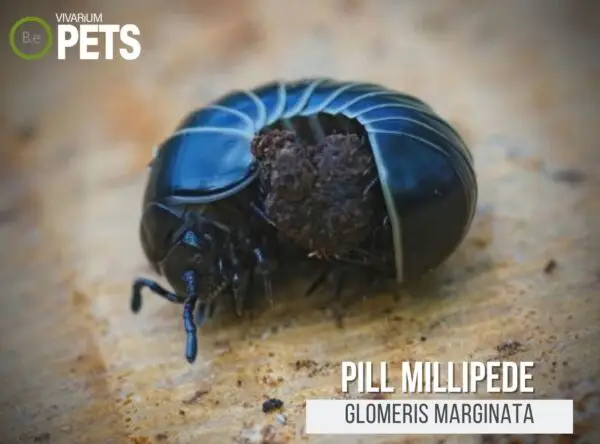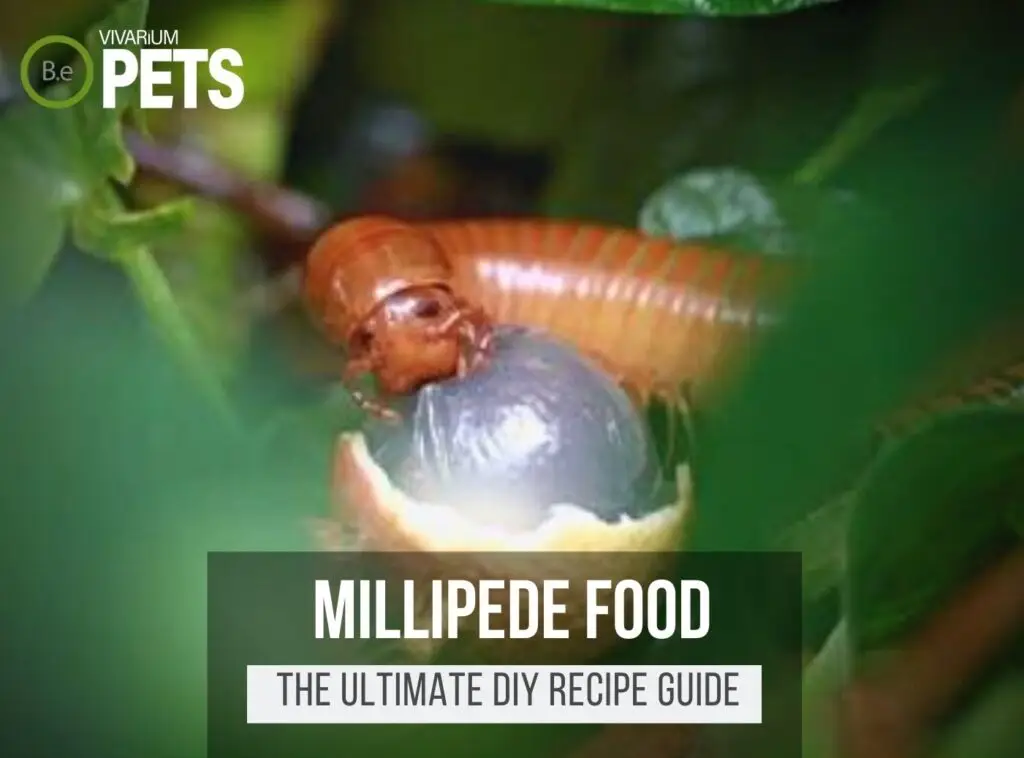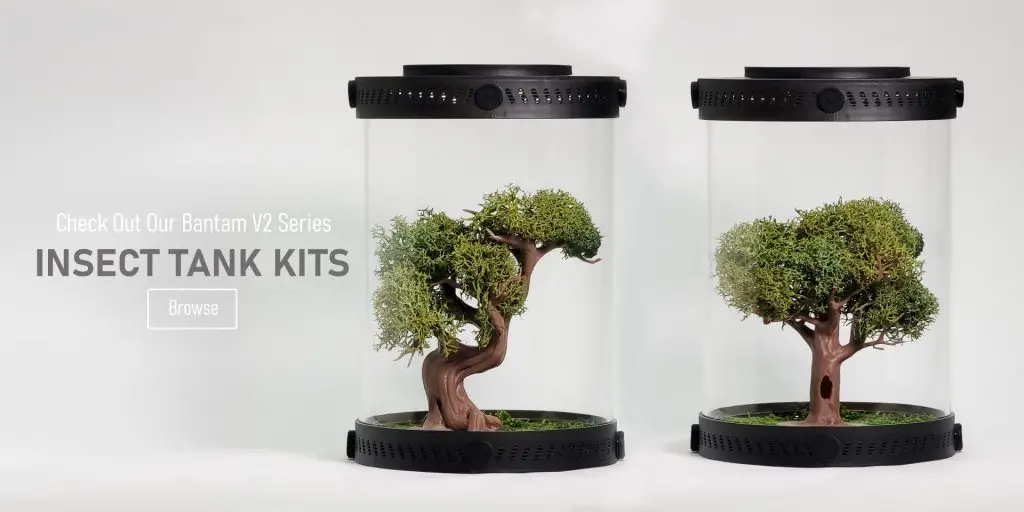Glomeris marginata, otherwise known as Pill Millipedes, are small, terrestrial creatures commonly confused with traditional pillbugs (isopods).
With their quirky, segmented structure and cute pill-like appendages, these fascinating little invertebrates have become popular pets for both experts and beginners alike.
This guide will provide you with everything you need to know about setting up an ideal habitat, feeding, and caring for them to ensure their well-being and longevity.
| Characteristics: | |
|---|---|
| Common Name | Pill Millipede |
| Family Name | Glomeridae |
| Scientific Name | Glomeris marginata |
| Use | Cleaning, Aerating Soil, Pets |
| Temperament | Non-aggressive |
| Lifespan | 11+ Years |
| Diet | Detritivore |
| Adult Size | 2.03 cm |
| Breeding Type | Egg Layer |
| Care Level | Easy |
| Minimum Tank Size | 5-10 Gallons |
| pH | 5.5-7.5 |
| Hardness | Soft |
| Temperature | 60-75°F |
Table Of Contents:
ToggleWhat Are Pill Millipedes?
Pill Millipedes, or Glomeris marginata, are small, terrestrial invertebrates that belong to the family Glomeridae.
They are found throughout Central and North Europe and gained the common name “Pill Millipede” due to their peculiar pill-like shape and segmented appendages.
Glomeris marginata is a rather small millipede in size, usually ranging from 8-14mm in length.
These unique little invertebrates can often be spotted in damp and moist soil, where they feed on decaying plant matter and decaying wood.
Create an ideal habitat for your millipede with our Customizable Millipede Enclosure Kits, which include everything you need to get started.
What Do Pill Millipedes Look Like?
Pill Millipedes are typically around 20mm long and have a unique, segmented body structure, often compared to that of a pill bug.
They typically have a yellowish-brown color, with black and brown stripes along the segments.
Each segment has two pairs of legs, giving them a total of 16 legs per body. Other notable features are their head and antennae, which are small and black.
They also have small and delicate pinchers located on the outside of their body, which they use to gain manual dexterity.
Glomeris marginata also has two distinct appendages protruding from their back, known as a ‘paranotal shield’.
These parasternal shields are usually a smooth, dark color and are often compared to that of a pill.
On the underside of their belly, they have two large, black spiracles used for respiration.
Lastly, their main abdominal segments have two openings known as the ‘stigmal plates,’ which they use to excrete their waste.
Benefits Of Using Pill Millipedes
Pill Millipedes are a great addition to terrariums and paludariums, bringing a unique and interesting presence.
Their ability to burrow helps to aerate the soil, providing oxygen to plant root systems and preventing the growth of unwanted fungi and bacteria.
Additionally, their slow and steady movement allows them to provide natural detritivorous activity, which helps to break down the decaying remains of plants and other organic matter.
They provide an aesthetically striking contrast to other animals and can even be used as part of an educational habitat setup.
Finally, they are relatively low-maintenance pets, as they require very little feeding, attention, and space.


Pill Millipede Facts
Glomeris marginata is a species of terrestrial, segmented invertebrates native to various parts of Europe.
In their natural habitat, they exhibit activity levels depending on the temperature of their environment; they tend to be slow-moving when temperatures are lower and increase their activity when the temperature is higher.
Pill millipedes usually reach adulthood after 1-2 years and can breed year-round in captivity, laying tiny, orange eggs on plant matter and soil.
Much like the Armidillidium species of isopods, these millipedes can curl up into tight balls when they feel threatened.
Habitat
The Pill Millipede is a species of invertebrate originating in North-western Europe.
They prefer damp habitats with plenty of leaf litter and underground burrows, so they can stay warm and moist.
They are also often found on the forest floors of deciduous and coniferous forests, where they can burrow up to well-drained soils.
These tiny creatures are generally nocturnal, so they hunt and feed during the night and rest during the day.
Their small size, the fact that they are relatively low-maintenance to care for, and their intriguing structure make them increasingly popular as pets in recent years.
So now, you’ll even find them in places not native to them, like Australia and parts of the United States.
Replicate their natural habitat perfectly with our Bioactive Millipede Substrate Blend, designed to provide the ideal moisture and organic content for your millipedes.
Diet
Pill Millipedes are primarily herbivorous in the wild. They prefer to feed on decaying leaves and plants that are very moist.
They are also known to feed on algae, mushrooms, lichens, and decaying wood. Some species in captivity have been known to accept small pieces of fruits such as apples and bananas.
The key for all of these bugs is privacy and moisture; pill millipedes prefer dark, moist environments in which to feast on this smorgasbord of vegetation.
Temperament
Pill Millipedes are generally peaceful creatures that do not display aggression or stress when handled or in their habitat.
As long as temperature, humidity, and occasional feeding requirements are met, they are quite resilient in captivity and will go about their routines without disrupting their environment.
They tend to be quite shy, so it is important to not disturb them too much.
However, they can be gently handled with patience and they might become curious about a human’s presence and explore when given the opportunity.
Pill Millipedes are also usually safe with other animals as well, but it is recommended that they should not be kept in the same enclosure with carnivores or insectivores as they could become a tasty snack.
Lifespan
Pill Millipedes have a relatively long life span, typically between 8 to 10 years.
They are hermaphroditic and unlike other millipede species, Pill Millipedes can reproduce without the need for mating.
In the wild, their breeding season starts in the spring and ends in late summer.
Young millipedes reach sexual maturity after a year, after which they will strive to mate with other Pill Millipedes in the area.
The female Pill Millipede can lay over ten clusters of two to three eggs each.
These will take around two weeks to hatch and the newly-born millipedes will already be well-developed.
They will grow in size, though usually at a much slower rate than other millipede species.
In the wild, Pill Millipedes often live in isolation, but they do congregate in large numbers to take advantage of favorable conditions such as food sources or moisture levels.
In captivity, these millipedes enjoy living in communal settings, where they can mingle and mate with one another.
Breeding
Pill Millipedes reproduce by using a courtship ritual involving physical contact and chemical communication between the two.
During mating season, male and female Pill Millipedes will seek out a mate, and once they are both ready engage in physical contact.
They do this by locking the front two legs, while the female will curl up into a ball to ensure secure contact.
Pill Millipedes lay their eggs in the soil, typically in moist and shady areas.
If a Pill Millipede is kept in captivity, the eggs should be removed and placed in a moist vermiculite container.
The eggs typically take between 6 and 8 weeks to hatch and the young will emerge looking much like their adult counterparts.
The young Pill Millipedes can reach maturity in about a year. Once mature, Pill Millipedes will mate and the cycle will begin again.
Where To Find Pill Millipedes
Pill Millipedes can be found in the wild in parts of Europe and Asia, most commonly living in leaf litter, soil, and compost piles.
If you’re looking to purchase Pill Millipedes, they can be bought from pet stores, online, or from breeders specializing in these creatures.
It’s important to be aware that some states have restrictions on importing millipedes and other invertebrates, so ensure you check with your local laws before doing so.
When shopping for Pill Millipedes, it’s important to observe the creatures before you purchase them.
Make sure that the millipedes look healthy, with straight bodies and bright eyes, and that their segments are not discolored and are the same color.
Also, bear in mind that younger Pill Millipedes tend to be more active than their older counterparts, so it’s best to choose young Millipedes if you’re looking for a more active pet.
Pill Millipede Care
Pill Millipedes require a moist, well-ventilated habitat with a damp terrarium substrate and a water dish. They should be provided with a nutrition-rich diet.
Additionally, the humidity level of their habitat should be monitored, and handling should be done with care due to their delicate exoskeleton.
With the right environment, food, and care, healthy, happy Pill Millipedes can live for years.
Tank Requirements
Pill Millipedes require a humid terrarium with a minimum of 2 inches of substrate, such as a mixture of coco soil, peat moss, and leaf litter.
The ideal temperature range for these creatures is 19-22 degrees Celsius, with a slightly acidic pH level of about 5.5-7.5, and a water hardness of 10-20 dKH for an optimum pad for health.
For lighting, a scheduled terrarium light with day/night cycles will provide the best environment and promote healthy growth.
To create a shadowy, moist atmosphere, consider adding live terrarium plants, wood, and rocks to your tank, as Glomeris marginata prefer to burrow and hide and like to retreat to shady spots.
What Do Pill Millipedes Eat?
Feeding Pill Millipedes may seem like a daunting task but it doesn’t have to be. Glomeris marginata is an omnivore and will happily eat a variety of food sources.
A healthy diet for your Pill Millipede should include:
- Fruits and vegetables: Examples include broccoli, apples, carrots, cauliflower, and tomatoes.
- Grains: Oats, wheat, or quinoa can be offered in small amounts as part of a balanced diet.
- Decaying insects: Mealworms are a popular insect treat for a variety of pet invertebrates.
- Leafy greens: Dark, leafy greens like spinach, kale, and Swiss chard can be offered in small amounts.
Your Pill Millipede should get a full meal two to three times per week. Spread its meals out so that it can maintain a balanced diet over a week.
If you’re more of an avid hobbyist like myself, check out my ultimate DIY Millipede food guide. I explain the best foods and my favorite recipe in more depth.
Best Tankmates For Pill Millipedes
Pill millipedes are communal species, meaning they thrive in the presence of other millipedes.
Keeping pill millipedes together in the same enclosure will allow them to engage in activities such as courting and socializing.
If you plan to house multiple millipedes in the same habitat, a larger enclosure is recommended.
In addition to other pill millipedes, other animals with similar beneficial qualities can be kept with them.
For example, springtails and isopods are tiny invertebrates that serve as natural tank cleaners, consuming uneaten food, decaying plants, and other waste that accumulates in the enclosure.
They also provide extra nutrition through their waste, which is appreciated among growing pill millipedes.
Aquatic snails can also serve as beneficial tank mates to pill millipedes.
While they do prefer water and moisture, they are also able to coexist with dry land creatures, such as pill millipedes.
They also help to keep mold at bay, which is especially beneficial for pill millipedes that need humid environments to stay healthy.
Conclusion
Caring for Pill Millipedes can be a rewarding experience and a great way to learn about caring for invertebrates.
With the proper knowledge of habitat setup, feeding, and general care, you’ll have a well-adjusted pet millipede that is full of life and vigor!
With a bit of dedication, your Glomeris marginata will surely thrive in your home.
Create the ideal habitat for your millipedes with our species-specific soil mixes and Insect Enclosure Kits. These products provide everything you need for a successful and thriving millipede colony.
Frequently Asked Questions
Pill millipedes (Glomeris marginata) are not isopods. They are actually a type of arthropod known as “diplopods”, which are commonly called millipedes.
Isopods, on the other hand, are a different type of arthropod that is also commonly called “pill bugs” or “rolly-pollies”.
While both diplopods and isopods have a segmented body and multiple legs, they have distinct differences in their anatomy and behavior.
Yes, pill millipedes (Glomeris marginata) are able to roll up into a tight ball as a defense mechanism against predators. Rolling up provides them with protection, as their hard exoskeleton and circular shape make it difficult for predators to access vulnerable parts of their bodies.
Pill millipedes are not harmful to humans or pets and can be beneficial in the ecosystem. However, some people may have an allergic reaction to their defensive secretions.
Yes, pill millipedes (Glomeris marginata) make good pets. They are peaceful, non–aggressive, and hardy animals that are easy to care for. They also add a unique and interesting touch to any terrarium.
The lifespan of a pill millipede (Glomeris marginata) can vary depending on factors such as temperature, humidity, and availability of food. In general, they can live for several years, with some individuals reportedly living up to 5 years in captivity. However, in the wild, their lifespan is likely to be shorter due to predation and other environmental factors.





